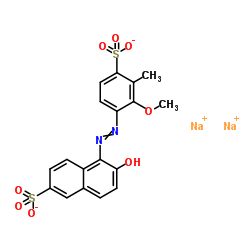食品红17

食品红17结构式

|
常用名 | 食品红17 | 英文名 | ALLURA RED AC |
|---|---|---|---|---|
| CAS号 | 25956-17-6 | 分子量 | 496.422 | |
| 密度 | N/A | 沸点 | N/A | |
| 分子式 | C18H14N2Na2O8S2 | 熔点 | 300ºC | |
| MSDS | 中文版 美版 | 闪点 | N/A |
|
Poly-N-acetylglucosamine matrix polysaccharide impedes fluid convection and transport of the cationic surfactant cetylpyridinium chloride through bacterial biofilms.
Appl. Environ. Microbiol. 75(5) , 1308-14, (2009) Biofilms are composed of bacterial cells encased in a self-synthesized, extracellular polymeric matrix. Poly-beta(1,6)-N-acetyl-d-glucosamine (PNAG) is a major biofilm matrix component in phylogenetically diverse bacteria. In this study we investigated the ph... |
|
|
Determination of allura red in some food samples by adsorptive stripping voltammetry.
J. AOAC Int. 88(5) , 1387-93, (2005) Square wave (SW) voltammetry was used to explore the adsorption properties of the food additive dye Allura Red on a hanging mercury drop electrode (HMDE). By using the adsorptive stripping voltammetric approach, we developed a sensitive electroanalytical meth... |
|
|
Development of a dye ingress method to assess container-closure integrity: correlation to microbial ingress.
PDA J. Pharm. Sci. Technol. 54(6) , 449-55, (2000) To demonstrate maintenance of parenteral product sterility, container-closure integrity over the shelf life of the product is critical. In the past, sterility testing has been used to ensure closure integrity. However, because of the limitations associated wi... |
|
|
Characterization of the interactions between polymethacrylate-based aqueous polymeric dispersions and aluminum lakes.
J. Pharm. Sci. 90(12) , 1937-47, (2001) Instability in film coating formulations can arise from interactions between aluminum lake pigments and aqueous polymeric dispersions. The purpose of this study was to characterize the interactions between three polymethacrylate-based aqueous polymeric disper... |
|
|
Anisotropic diffusion deviates chicken embryo chorioallantoic membrane assay (CAM) to reflect inherent therapeutic behaviors.
Colloids Surf. B Biointerfaces 70(1) , 29-34, (2009) Chorioallantoic membrane assay (CAM) has become a widely used tool for determination of anti-angiogenesis capability of many drugs including herbal extracts. Because varying results in same set of chicken embryos are often encountered, we developed the comple... |
|
|
Kinetics of adsorption of sulphonated azo dyes on strong basic anion exchangers.
Environ. Technol. 30(10) , 1059-71, (2009) The macroporous polystyrene anion exchangers Amberlite IRA-900 and Amberlite IRA-910 were used in order to remove sulphonated azo dyes (Allura Red and Sunset Yellow) from aqueous solutions of 100-500 mg/L concentrations. The experimental data obtained at 100,... |
|
|
Genotoxicity assessment of amaranth and allura red using Saccharomyces cerevisiae.
Bull. Environ. Contam. Toxicol. 90(1) , 22-6, (2013) Amaranth (E123) and Allura red (E129), very important food azo dyes used in food, drug, paper, cosmetic and textile industries, were assessed for their genotoxic potential through comet assay in yeast cells. Comet assay was standardized by with different conc... |
|
|
Influence of synthetic and natural food dyes on activities of CYP2A6, UGT1A6, and UGT2B7.
J. Toxicol. Environ. Health A 68(16) , 1431-44, (2005) Synthetic or natural food dyes are typical xenobiotics, as are drugs and pollutants. After ingestion, part of these dyes may be absorbed and metabolized by phase I and II drug-metabolizing enzymes and excreted by transporters of phase III enzymes. However, th... |
|
|
Assessment of the exposure to Allura Red colour from the consumption of red juice-based and red soft drinks in Italy.
Food Addit. Contam. Part A. Chem. Anal. Control. Expo. Risk Assess. 28(11) , 1501-15, (2011) This article reports the results of a survey and an exposure study, based on a probabilistic approach, concerning red juice-based and red soft drink products in Italy. It highlights the fact that the estimates of both the consumption rates and colorant intake... |
|
|
Adsorption of allura red dye by cross-linked chitosan from shrimp waste.
Water Sci. Technol. 65(4) , 618-23, (2012) The present study was designed to evaluate the chitosan, which has been obtained by deacetylation of chitin, as a biosorbent. The chitin was isolated from fermented shrimp waste by an important local industrial food biopolymer. The aim of this work was the ch... |